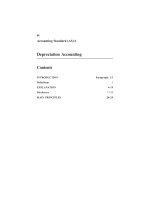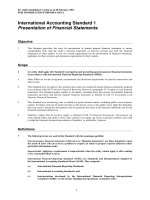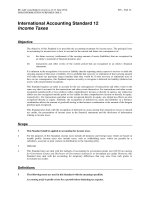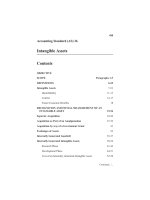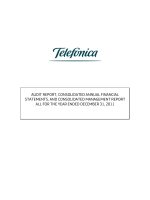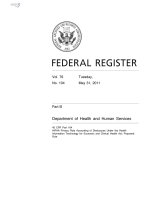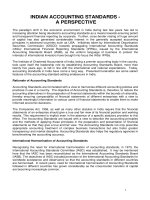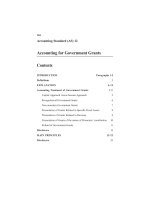Indian Accounting Standard (Ind AS) 27 Consolidated and Separate Financial Statements potx
Bạn đang xem bản rút gọn của tài liệu. Xem và tải ngay bản đầy đủ của tài liệu tại đây (912 KB, 44 trang )
Indian Accounting Standard (Ind AS) 27
Consolidated and Separate Financial Statements
Contents Paragraphs
Scope 1-3
Definitions 4-8
Presentation of Consolidated Financial
Statements
9-11
Scope of Consolidated Financial Statements 12-17
Consolidation Procedures 18-31
Loss of Control 32-37
Separate financial statements 35-36
Accounting for Investments in Subsidiaries,
Jointly Controlled Entities and Associates in
Separate Financial Statements
38-40
Disclosure 41-43
APPENDICIES
Appendix A: Consolidation––Special Purpose Entities
Appendix B: References to matters contained in other Indian
Accounting Standards
Appendix C: Form of consolidated financial statements
Appendix 1: Comparison with IAS 27, Consolidated and
Separate Financial Statements
Indian Accounting Standard (Ind AS) 27
Consolidated and Separate Financial Statements
(This Indian Accounting Standard includes paragraphs set in bold type and plain type,
which have equal authority. Paragraphs in bold type indicate the main principles).
Scope
1 This Standard shall be applied in the preparation and presentation of
consolidated financial statements for a group of entities under the control of a
parent.
2 This Standard does not deal with methods of accounting for business combinations
and their effects on consolidation, including goodwill arising on a business combination
(see Ind AS 103 Business Combinations).
3 This Standard shall also be applied in accounting for investments in
subsidiaries, jointly controlled entities and associates when an entity elects, or is
required by law, to present separate financial statements.
Definitions
4 The following terms are used in this Standard with the meanings specified:
Consolidated financial statements are the financial statements of a group presented
as those of a single economic entity.
Control is the power to govern the financial and operating policies of an entity so
as to obtain benefits from its activities.
A group is a parent and all its subsidiaries.
Non-controlling interest is the equity in a subsidiary not attributable, directly or
indirectly, to a parent.
A parent is an entity that has one or more subsidiaries.
Separate financial statements are those presented by a parent, an investor in an
associate or a venturer in a jointly controlled entity, in which the investments are
accounted for on the basis of the direct equity interest rather than on the basis of
the reported results and net assets of the investees.
2
A subsidiary is an entity, including an unincorporated entity such as a partnership,
that is controlled by another entity (known as the parent).
5 A parent or its subsidiary may be an investor in an associate or a venturer in a jointly
controlled entity. In such cases, consolidated financial statements prepared and
presented in accordance with this Standard are also prepared so as to comply with Ind
AS 28 Investments in Associates and Ind AS 31 Interests in Joint Ventures.
6 For an entity described in paragraph 5, separate financial statements are those
prepared and presented in addition to the financial statements referred to in paragraph
5. Separate financial statements need not be appended to, or accompany, those
statements, unless required by law.
7 The financial statements of an entity that does not have a subsidiary, associate or
venturer’s interest in a jointly controlled entity are not separate financial statements.
8 [Refer to Appendix 1]
.
Presentation of Consolidated Financial Statements
9 A parent shall present consolidated financial statements in which it
consolidates its investments in subsidiaries in accordance with this Standard.
Where a parent is a company, the consolidated financial statements shall be in
the form set out in Appendix C to this Standard or as near thereto as
circumstances admit.
10 (Refer to Appendix 1)
11 A parent presents separate financial statements in compliance with paragraphs 38–
43.
Scope of Consolidated Financial Statements
12 Consolidated financial statements shall include all subsidiaries of the parent.
1
13 Control is presumed to exist when the parent owns, directly or indirectly through
subsidiaries, more than half of the voting power of an entity unless, in exceptional
circumstances, it can be clearly demonstrated that such ownership does not constitute
control. Control also exists when the parent owns half or less of the voting power of an
entity when there is:
2
1
If on acquisition a subsidiary meets the criteria to be classified as held for sale in accordance with Ind
AS 105 Non-current Assets Held for Sale and Discontinued Operations, it shall be accounted for in
accordance with that Indian Accounting Standard.
2
2
See also Appendix A Consolidation––Special Purpose Entities.
3
(a) power over more than half of the voting rights by virtue of an agreement with
other investors;
(b) power to govern the financial and operating policies of the entity under a statute
or an agreement;
(c) power to appoint or remove the majority of the members of the board of directors
or equivalent governing body and control of the entity is by that board or body; or
(d) power to cast the majority of votes at meetings of the board of directors or
equivalent governing body and control of the entity is by that board or body.
14 An entity may own share warrants, share call options, debt or equity instruments that
are convertible into ordinary shares
3
, or other similar instruments that have the potential,
if exercised or converted, to give the entity voting power or reduce another party’s voting
power over the financial and operating policies of another entity (potential voting rights).
The existence and effect of potential voting rights that are currently exercisable or
convertible, including potential voting rights held by another entity, are considered when
assessing whether an entity has the power to govern the financial and operating policies
of another entity. Potential voting rights are not currently exercisable or convertible
when, for example, they cannot be exercised or converted until a future date or until the
occurrence of a future event.
15 In assessing whether potential voting rights contribute to control, the entity examines
all facts and circumstances (including the terms of exercise of the potential voting rights
and any other contractual arrangements whether considered individually or in
combination) that affect potential voting rights, except the intention of management and
the financial ability to exercise or convert such rights.
16 A subsidiary is not excluded from consolidation simply because the investor is a
venture capital organisation, mutual fund, unit trust or similar entity.
17 A subsidiary is not excluded from consolidation because its business activities are
dissimilar from those of the other entities within the group. Relevant information is
provided by consolidating such subsidiaries and disclosing additional information in the
consolidated financial statements about the different business activities of subsidiaries.
For example, the disclosures required by Ind AS 108 Operating Segments help to
explain the significance of different business activities within the group.
Consolidation Procedure
18 In preparing consolidated financial statements, an entity combines the financial
statements of the parent and its subsidiaries line by line by adding together like items of
assets, liabilities, equity, income and expenses. In order that the consolidated financial
statements present financial information about the group as that of a single economic
entity, the following steps are then taken:
3
In Indian context, the term ‘ordinary shares’ is equivalent to ‘equity shares’.
4
(a) the carrying amount of the parent’s investment in each subsidiary and the parent’s
portion of equity of each subsidiary are eliminated (see Ind AS 103 Business
Combinations, which describes the treatment of any resultant goodwill);
(b) non-controlling interests in the profit or loss of consolidated subsidiaries for the
reporting period are identified; and
(c) non-controlling interests in the net assets of consolidated subsidiaries are identified
separately from the parent’s ownership interests in them. Non-controlling interests in
the net assets consist of:
(i) the amount of those non-controlling interests at the date of the original
combination calculated in accordance with Ind AS 103 Business Combinations
and
(ii) the non-controlling interests’ share of changes in equity since the date of the
combination.
19 When potential voting rights exist, the proportions of profit or loss and changes in
equity allocated to the parent and non-controlling interests are determined on the basis
of present ownership interests and do not reflect the possible exercise or conversion of
potential voting rights.
20 Intragroup balances, transactions, income and expenses shall be eliminated in
full.
21 Intragroup balances and transactions, including income, expenses and dividends, are
eliminated in full. Profits and losses resulting from intragroup transactions that are
recognised in assets, such as inventory and fixed assets, are eliminated in full.
Intragroup losses may indicate an impairment that requires recognition in the
consolidated financial statements. Ind AS 12 Income Taxes applies to temporary
differences that arise from the elimination of profits and losses resulting from intragroup
transactions.
22 The financial statements of the parent and its subsidiaries used in the
preparation of the consolidated financial statements shall be prepared as of the
same date. When the end of the reporting period of the parent is different from
that of a subsidiary, the subsidiary prepares, for consolidation purposes,
additional financial statements as of the same date as the financial statements of
the parent unless it is impracticable to do so.
23 When, in accordance with paragraph 22, the financial statements of a
subsidiary used in the preparation of consolidated financial statements are
prepared as of a date different from that of the parent’s financial statements,
adjustments shall be made for the effects of significant transactions or events that
occur between that date and the date of the parent’s financial statements. In any
case, the difference between the end of the reporting period of the subsidiary and
that of the parent shall be no more than three months. The length of the reporting
periods and any difference between the ends of the reporting periods shall be the
same from period to period.
5
24 Consolidated financial statements shall be prepared using uniform
accounting policies for like transactions and other events in similar
circumstances.
25 If a member of the group uses accounting policies other than those adopted in the
consolidated financial statements for like transactions and events in similar
circumstances, appropriate adjustments are made to its financial statements in preparing
the consolidated financial statements.
26 The income and expenses of a subsidiary are included in the consolidated financial
statements from the acquisition date as defined in Ind AS 103 Business Combinations.
Income and expenses of the subsidiary shall be based on the values of the assets and
liabilities recognised in the parent’s consolidated financial statements at the acquisition
date. For example, depreciation expense recognised in the consolidated statement of
profit and loss after the acquisition date shall be based on the fair values of the related
depreciable assets recognised in the consolidated financial statements at the acquisition
date. The income and expenses of a subsidiary are included in the consolidated financial
statements until the date when the parent ceases to control the subsidiary.
27 Non-controlling interests shall be presented in the consolidated balance sheet
within equity, separately from the equity of the owners of the parent.
28 Profit or loss and each component of other comprehensive income are attributed to
the owners of the parent and to the non-controlling interests. Total comprehensive
income is attributed to the owners of the parent and to the non-controlling interests even
if this results in the non-controlling interests having a deficit balance.
29 If a subsidiary has outstanding cumulative preference shares that are classified as
equity and are held by non-controlling interests, the parent computes its share of profit or
loss after adjusting for the dividends on such shares, whether or not dividends have
been declared.
30 Changes in a parent’s ownership interest in a subsidiary that do not result in a
loss of control are accounted for as equity transactions (i.e transactions with
owners in their capacity as owners).
31 In such circumstances the carrying amounts of the controlling and non-controlling
interests shall be adjusted to reflect the changes in their relative interests in the
subsidiary. Any difference between the amount by which the non-controlling interests are
adjusted and the fair value of the consideration paid or received shall be recognised
directly in equity and attributed to the owners of the parent.
Loss of Control
32 A parent can lose control of a subsidiary with or without a change in absolute or
relative ownership levels. This could occur, for example, when a subsidiary becomes
subject to the control of a government, court, administrator or regulator. It also could
occur as a result of a contractual agreement.
6
33 A parent might lose control of a subsidiary in two or more arrangements
(transactions). However, sometimes circumstances indicate that the multiple
arrangements should be accounted for as a single transaction. In determining whether to
account for the arrangements as a single transaction, a parent shall consider all of the
terms and conditions of the arrangements and their economic effects. One or more of
the following may indicate that the parent should account for the multiple arrangements
as a single transaction:
(a) They are entered into at the same time or in contemplation of each other.
(b) They form a single transaction designed to achieve an overall commercial effect.
(c) The occurrence of one arrangement is dependent on the occurrence of at least one
other arrangement.
(d) One arrangement considered on its own is not economically justified, but it is
economically justified when considered together with other arrangements. An
example is when one disposal of shares is priced below market and is compensated
for by a subsequent disposal priced above market.
34 If a parent loses control of a subsidiary, it:
a) derecognises the assets (including any goodwill) and liabilities of the
subsidiary at their carrying amounts at the date when control is lost;
(b) derecognises the carrying amount of any non-controlling interests in the
former subsidiary at the date when control is lost (including any components
of other comprehensive income attributable to them);
(c) recognises:
(i) the fair value of the consideration received, if any, from the transaction,
event or circumstances that resulted in the loss of control; and
(ii) if the transaction that resulted in the loss of control involves a distribution
of shares of the subsidiary to owners in their capacity as owners, that
distribution;
(d) recognises any investment retained in the former subsidiary at its fair value at
the date when control is lost;
(e) reclassifies to profit or loss, or transfers directly to retained earnings if
required in accordance with other Indian Accounting Standards, the amounts
identified in paragraph 35; and
(f) recognises any resulting difference as a gain or loss in profit or loss
attributable to the parent.
35. If a parent loses control of a subsidiary, the parent shall account for all amounts
recognised in other comprehensive income in relation to that subsidiary on the same
basis as would be required if the parent had directly disposed of the related assets or
7
liabilities. Therefore, if a gain or loss previously recognised in other comprehensive
income would be reclassified to profit or loss on the disposal of the related assets or
liabilities, the parent reclassifies the gain or loss from equity to profit or loss (as a
reclassification adjustment) when it loses control of the subsidiary. For example, if a
subsidiary has available-for-sale financial assets and the parent loses control of the
subsidiary, the parent shall reclassify to profit or loss the gain or loss previously
recognised in other comprehensive income in relation to those assets. Similarly, if a
revaluation surplus previously recognised in other comprehensive income would be
transferred directly to retained earnings on the disposal of the asset, the parent transfers
the revaluation surplus directly to retained earnings when it loses control of the
subsidiary.
36 On the loss of control of a subsidiary, any investment retained in the former
subsidiary and any amounts owed by or to the former subsidiary shall be
accounted for in accordance with other Indian Accounting Standards from the
date when control is lost.
37 The fair value of any investment retained in the former subsidiary at the date when
control is lost shall be regarded as the fair value on initial recognition of a financial asset
in accordance with Ind AS 39 Financial Instruments: Recognition and Measurement or,
when appropriate, the cost on initial recognition of an investment in an associate or
jointly controlled entity.
Accounting for Investments in Subsidiaries, Jointly
Controlled Entities and Associates in Separate Financial
Statements
38 For preparing separate financial statements the entity shall account for
investments in subsidiaries, jointly controlled entities and associates either:
(a) at cost, or
(b) in accordance with Ind AS 39
The entity shall apply the same accounting for each category of investments.
Investments accounted for at cost shall be accounted for in accordance with Ind
AS 105 Non-current Assets Held for Sale and Discontinued Operations when they
are classified as held for sale (or included in a disposal group that is classified as
held for sale) in accordance with Ind AS 105. The measurement of investments
accounted for in accordance with Ind AS 39 is not changed in such
circumstances.
38A An entity shall recognise a dividend from a subsidiary, jointly controlled
entity or associate in profit or loss in its separate financial statements when its
right to receive the dividend is established.
38B When a parent reorganises the structure of its group by establishing a new entity as
its parent in a manner that satisfies the following criteria:
8
(a) the new parent obtains control of the original parent by issuing equity instruments
in exchange for existing equity instruments of the original parent;
(b) the assets and liabilities of the new group and the original group are the same
immediately before and after the reorganisation; and
(c) the owners of the original parent before the reorganisation have the same absolute
and relative interests in the net assets of the original group and the new group
immediately before and after the reorganisation
and the new parent accounts for its investment in the original parent in accordance
with paragraph 38(a) in its separate financial statements, the new parent shall
measure cost at the carrying amount of its share of the equity items shown in the
separate financial statements of the original parent at the date of the reorganisation.
38C Similarly, an entity that is not a parent might establish a new entity as its parent in a
manner that satisfies the criteria in paragraph 38B. The requirements in paragraph 38B
apply equally to such reorganisations. In such cases, references to ‘original parent’ and
‘original group’ are to the ‘original entity’.
39 This Standard does not mandate which entities produce separate financial
statements available for public use. Paragraphs 38 and 40–43 are applied by an entity
for preparing separate financial statements that comply with Indian Accounting
Standards. The entity also produces consolidated financial statements available for
public use as required by paragraph 9, unless exempted under law.
40 Investments in jointly controlled entities and associates that are accounted for
in accordance with Ind AS 39 in the consolidated financial statements shall be
accounted for in the same way in the investor’s separate financial statements.
Disclosures
41 The following disclosures shall be made in consolidated financial statements:
(a) the nature of the relationship between the parent and a subsidiary when the
parent does not own, directly or indirectly through subsidiaries, more than half of
the voting power;
(b) the reasons why the ownership, directly or indirectly through subsidiaries, of
more than half of the voting or potential voting power of an investee does not
constitute control;
(c) the end of the reporting period of the financial statements of a subsidiary when
such financial statements are used to prepare consolidated financial statements
and are as of a date or for a period that is different from that of the parent’s
financial statements, and the reason for using a different date or period;
(d) the nature and extent of any significant restrictions (e.g. resulting from
borrowing arrangements or regulatory requirements) on the ability of subsidiaries
9
to transfer funds to the parent in the form of cash dividends or to repay loans or
advances;
(e) a schedule that shows the effects of any changes in a parent’s ownership
interest in a subsidiary that do not result in a loss of control on the equity
attributable to owners of the parent; and
(f) if control of a subsidiary is lost, the parent shall disclose the gain or loss, if
any, recognised in accordance with paragraph 34, and:
(i) the portion of that gain or loss attributable to recognising any investment
retained in the former subsidiary at its fair value at the date when control is
lost; and
(ii) the line item(s) in the statement of profit and loss in which the gain or loss
is recognised (if not presented separately in the statement of profit and
loss).
42 [Refer to Appendix 1]
43 Separate financial statements of a parent, venturer with an interest in a jointly
controlled entity or an investor in an associate shall disclose:
(a) the fact that the statements are separate financial statements;
(b) a list of significant investments in subsidiaries, jointly controlled entities and
associates, including the name, country of incorporation or residence,
proportion of ownership interest and, if different, proportion of voting power
held; and
(c) a description of the method used to account for the investments listed under
(b);
and shall identify the financial statements prepared in accordance with paragraph
9 of this Standard (unless preparation of consolidated financial statements is
exempt under law) or Ind AS 28 and Ind AS 31 to which they relate.
10
Appendix A
This Appendix is an integral part of Indian Accounting Standard (Ind AS) 27.
Consolidation––Special Purpose Entities
Issue
1 An entity may be created to accomplish a narrow and well-defined objective (e.g.,
to effect a lease, research and development activities or a securitisation of financial
assets). Such a special purpose entity (‘SPE’) may take the form of a corporation,
trust, partnership or unincorporated entity. SPEs often are created with legal
arrangements that impose strict and sometimes permanent limits on the decision-
making powers of their governing board, trustee or management over the
operations of the SPE. Frequently, these provisions specify that the policy guiding
the ongoing activities of the SPE cannot be modified, other than perhaps by its
creator or sponsor (i.e., they operate on so-called ‘autopilot’).
2 The sponsor (or entity on whose behalf the SPE was created) frequently transfers
assets to the SPE, obtains the right to use assets held by the SPE or performs
services for the SPE, while other parties (‘capital providers’) may provide the
funding to the SPE. An entity that engages in transactions with an SPE (frequently
the creator or sponsor) may in substance control the SPE.
3 A beneficial interest in an SPE may, for example, take the form of a debt
instrument, an equity instrument, a participation right, a residual interest or a lease.
Some beneficial interests may simply provide the holder with a fixed or stated rate
of return, while others give the holder rights or access to other future economic
benefits of the SPE’s activities. In most cases, the creator or sponsor (or the entity
on whose behalf the SPE was created) retains a significant beneficial interest in the
SPE’s activities, even though it may own little or none of the SPE’s equity.
4 Ind AS 27 requires the consolidation of entities that are controlled by the
reporting entity. While the standard does not provide explicit guidance on the
consolidation of SPEs, this Appendix does so.
5 The issue is under what circumstances an entity should consolidate an SPE.
6 This Appendix does not apply to post-employment benefit plans or other long-term
employee benefit plans to which Ind AS 19 applies.
7 A transfer of assets from an entity to an SPE may qualify as a sale by that entity.
Even if the transfer does qualify as a sale, the provisions of this Standard including
this Appendix may mean that the entity should consolidate the SPE. This Appendix
does not address the circumstances in which sale treatment should apply for the
entity or the elimination of the consequences of such a sale upon consolidation.
11
Accounting Principles
8 An SPE shall be consolidated when the substance of the relationship between an
entity and the SPE indicates that the SPE is controlled by that entity.
9 In the context of an SPE, control may arise through the predetermination of the
activities of the SPE (operating on ‘autopilot’) or otherwise. Paragraph 13 of this
Standard indicates several circumstances which result in control even in cases
where an entity owns one half or less of the voting power of another entity.
Similarly, control may exist even in cases where an entity owns little or none of the
SPE’s equity. The application of the control concept requires, in each case,
judgement in the context of all relevant factors.
10 In addition to the situations described in paragraph 13 of this Standard, the following
circumstances, for example, may indicate a relationship in which an entity controls
an SPE and consequently should consolidate the SPE (additional guidance is
provided by way of indicators of control over an SPE given along with this
Appendix):
(a) in substance, the activities of the SPE are being conducted on behalf of the
entity according to its specific business needs so that the entity obtains
benefits from the SPE’s operation;
(b) in substance, the entity has the decision-making powers to obtain the majority
of the benefits of the activities of the SPE or, by setting up an ‘autopilot’
mechanism, the entity has delegated these decision-making powers;
(c) in substance, the entity has rights to obtain the majority of the benefits of the
SPE and therefore may be exposed to risks incident to the activities of the
SPE; or
(d) in substance, the entity retains the majority of the residual or ownership risks
related to the SPE or its assets in order to obtain benefits from its activities.
12
Indicators of control over an SPE
These indicators accompany, but are not part of, Appendix A.
The examples in paragraph 10 of Appendix A are intended to indicate types of
circumstances that should be considered in evaluating a particular arrangement in
light of the substance-over-form principle. The guidance provided in Appendix A
and in these indicators of control over an SPE are not intended to be used as ‘a
comprehensive checklist’ of conditions that must be met cumulatively in order to
require consolidation of an SPE.
(a) Activities
The activities of the SPE, in substance, are being conducted on behalf of the reporting
entity, which directly or indirectly created the SPE according to its specific business
needs.
Examples are:
• the SPE is principally engaged in providing a source of long-term capital to an
entity or funding to support an entity’s ongoing major or central operations; or
• the SPE provides a supply of goods or services that is consistent with an entity’s
ongoing major or central operations which, without the existence of the SPE, would
have to be provided by the entity itself.
Economic dependence of an entity on the reporting entity (such as relations of suppliers
to a significant customer) does not, by itself, lead to control.
(b) Decision-making
The reporting entity, in substance, has the decision-making powers to control or to
obtain control of the SPE or its assets, including certain decision-making powers coming
into existence after the formation of the SPE. Such decision-making powers may have
been delegated by establishing an ‘autopilot’ mechanism.
Examples are:
• power to unilaterally dissolve an SPE;
• power to change the SPE’s charter or bylaws; or
• power to veto proposed changes of the SPE’s charter or bylaws.
(c) Benefits
The reporting entity, in substance, has rights to obtain a majority of the benefits of the
SPE’s activities through a statute, contract, agreement, or trust deed, or any other
scheme, arrangement or device. Such rights to benefits in the SPE may be indicators of
control when they are specified in favour of an entity that is engaged in transactions with
13
an SPE and that entity stands to gain those benefits from the financial performance of
the SPE.
Examples are:
• rights to a majority of any economic benefits distributed by an entity in the form of
future net cash flows, earnings, net assets, or other economic benefits; or
• rights to majority residual interests in scheduled residual distributions or in a
liquidation of the SPE
(d) Risks
An indication of control may be obtained by evaluating the risks of each party engaging
in transactions with an SPE. Frequently, the reporting entity guarantees a return or credit
protection directly or indirectly through the SPE to outside investors who provide
substantially all of the capital to the SPE. As a result of the guarantee, the entity retains
residual or ownership risks and the investors are, in substance, only lenders because
their exposure to gains and losses is limited
Examples are:
• the capital providers do not have a significant interest in the underlying net
assets of the SPE;
• the capital providers do not have rights to the future economic benefits of the
SPE;
• the capital providers are not substantively exposed to the inherent risks of the
underlying net assets or operations of the SPE; or
• in substance, the capital providers receive mainly consideration equivalent to a
lender’s return through a debt or equity interest.
14
Appendix B
References to matters contained in other Indian
Accounting Standards
This Appendix is an integral part of Indian Accounting Standard (Ind AS) 27.
1. Appendix A, Distribution of Non-cash Assets to Owners contained in Ind AS 10
Events after the Reporting Period makes reference to this Standard also.
2. Appendix A, Rights to Interests arising from Decommissioning, Restoration and
Environmental Rehabilitation Funds contained in Ind AS 37 Provisions,
Contingent Liabilities and Contingent Assets (makes reference to this Standard
also.
15
Appendix C
Form of consolidated financial statements
(This Appendix is an integral part of Indian Accounting Standard 27)
GENERAL INSTURCTIONS FOR PREPARATION OF CONSOLIDATED FINANCIAL
STATEMENTS
GENERAL INSTRUCTIONS
1. This Appendix shall apply to companies, for preparation of Consolidated Financial
Statements.
2. This Appendix sets out the minimum requirements for disclosure on the face of
(a) the Consolidated Balance Sheet at the end of the period and a
Consolidated Statement of Changes in Equity for the period as a part of
the Consolidated Balance Sheet,
(b) the Consolidated Statement of Profit and Loss for the period. (The term
Consolidated ‘Statement of Profit and Loss’ has the same meaning as
‘Consolidated Profit and Loss Account’).
(c) Notes
(hereinafter referred to as “Consolidated Financial Statements” for the
purpose of this Appendix).
Line items, sub-line items and sub-totals shall be presented as an addition or
substitution on the face of the Consolidated Financial Statements when such
presentation is relevant to an understanding of the Group’s (i.e. the parent and
its subsidiaries) financial position or performance or to cater to industry/sector-
specific disclosure requirements or when required for compliance with any law or
under the Indian Accounting Standards.
3. Where compliance with the requirements of any law including Indian Accounting
Standards as applicable to the companies require any change in treatment or
disclosure including addition, amendment, substitution or deletion in the
head/sub-head or any changes interse, in the consolidated financial statements
or statements forming part thereof, the same shall be made and the
requirements of this Appendix shall stand modified accordingly.
16
4. The disclosure requirements specified in Part I and Part II of this Appendix are in
addition to and not in substitution of the disclosure requirements specified in the
Indian Accounting Standards. Additional disclosures specified in the Indian
Accounting Standards shall be made in the notes to accounts or by way of
additional statement unless required to be disclosed on the face of the
Consolidated Financial Statements. Similarly, all other disclosures as required by
any law shall be made in the notes to accounts in addition to the requirements
set out in this Appendix.
5. Notes to accounts shall contain information in addition to that presented in the
Consolidated Financial Statements and shall provide where required (a) narrative
descriptions or disaggregations of items recognized in those statements and (b)
information about items that do not qualify for recognition in those statements.
Each item on the face of the Consolidated Balance Sheet and Consolidated
Statement of Profit and Loss shall be cross-referenced to any related information
in the notes to accounts. In preparing the Consolidated Financial Statements
including the notes to accounts, a balance shall be maintained between providing
excessive detail that may not assist users of financial statements and not
providing important information as a result of too much aggregation.
6. Depending upon the turnover of the Group, the figures appearing in the
Consolidated Financial Statements may be rounded off as below:
Turnover Rounding off
(i) less than one hundred crore
rupees
To the nearest hundreds, thousands,
lakhs or millions, or decimals thereof.
(ii) one hundred crore rupees or
more
To the nearest, lakhs, millions or crores,
or decimals thereof.
Once a unit of measurement is used, it should be used uniformly in the
Consolidated Financial Statements.
7. Except in the case of the first Consolidated Financial Statements laid before the
Company (after its incorporation) the corresponding amounts (comparatives) for
the immediately preceding reporting period for all items shown in the
Consolidated Financial Statements including notes shall also be given.
8. For the purpose of this Appendix, the terms used herein shall be as per the
applicable Indian Accounting Standards.
17
PART I – CONSOLIDATED
BALANCE SHEET
Name of the Group…………………….
Consolidated
Balance Sheet as at ………………………
(Rupees
in…………)
18
Particulars
Note No. Figures as at the end of
current reporting period
Figures
as at the
end of
the
previous
reporting
period
1 2 3
19
I.
(1)
(2)
(3)
(4)
EQUITY AND LIABILITIES
Equity
Equity attributable to owners of the
parent
(a) Equity Share capital
(b) Other Equity
(i) Equity component of other financial
instruments
(ii) Retained Earnings
(iii) Reserves
1.1 Reserves representing unrealised
gains/losses
1.2 Other Reserves
(iv) Money received against share
warrants
(v) Others
Equity attributable to non-controlling
Interests
(a) Equity Share Capital
(b) Other equity
Share application money pending
allotment
Non-current liabilities
(a) Financial Liabilities
(i) Liability component of other financial
instruments
(ii) Long-term borrowings
(iii) Others
(b) Liabilities associated with group(s)of
assets held for disposal
(c) Long-term provisions
(d) Deferred tax liabilities (Net)
(e ) Other non-current liabilities
Current liabilities
(a) Financial Liabilities
(i) Short Term Borrowings
(ii) Trade and other payables
(ii) Others
(b) Other current liabilities
(c) Short-term provisions
(d) Liabilities for Current Tax (Net)
TOTAL
20
II.
(1)
(2)
ASSETS
Non-current assets
(a) Property, Plant and Equipment
(b) Capital work-in-progress
(c) Investment Property
(d) Intangible Assets
(i) Goodwill
(ii) Other intangible assets
(iii) Intangible assets under
development
(e) Biological Assets
(f) Financial Assets
(i) Non-current investments
(ii) Long-term loans and advances
(iii) Others
(g) Deferred tax assets (net)
(h) Other non-current assets
Current assets
(a) Inventories
(b) Financial Assets
(i) Current investments
(ii) Trade and other receivables
(iii) Cash and cash equivalents
(iv) Short-term loans and advances
(c) Non-current assets classified as held for
sale
(d) Assets for Current Tax (Net)
(e) Other current assets
TOTAL
See accompanying notes to the consolidated financial statements
CONSOLIDATED STATEMENT OF CHANGES IN EQUITY (presented as a part of
Consolidated Balance Sheet)
Name of the Group…………………….
Consolidated Statement of Changes in Equity for the period ended ……………………
(Rupees in…………… )
a. Equity Share Capital
Balance at the
beginning of the
reporting period
Balance
Changes in equity
share capital during
the year
Balance at the end of
the reporting period
21
Attributable to
owners of the
parent
xxx
xxx xxx
Attributable to
non-controlling
interests
xxx xxx xxx
Total xxx xxx xxx
b. Other Equity
Balance
at the
beginni
ng of
the
reporti
ng
period
Changes in
accounting
policy/prior
period
errors
Restated
balance
at the
beginning
of the
reporting
period
Dividends Total
Comprehen
sive
Income for
the year
Transfer
to
retained
earnings
Any other
change (to
be
specified)
Balance
at the
end of
the
reportin
g
period
(i) Equity
component of
other financial
instruments
xxx xxx xxx xxx
(ii) Retained
Earnings
xxx xxx xxx (xxx) xxx xxx xxx xxx
(iii) Reserves
1.1
Reserves
representing
unrealised
gains/losses
Available for sale
financial assets
xxx xxx xxx xxx xxx
Effective portion
of Cash Flow
Hedges
xxx xxx xxx xxx xxx
Re-valuation
Surplus
xxx xxx xxx (xxx) xxx xxx
22
Actuarial gains
and losses in
defined benefit
plans
xxx xxx xxx xxx xxx
Exchange
differences on
translating the
financial
statements of a
foreign operation
xxx xxx xxx xxx xxx
Others
xxx xxx xxx xxx xxx xxx
1.2
Other
Reserves
(iii) Total
Reserves
xxx xxx
xxx xxx
(iv) Money
received
against share
warrants
xxx xxx xxx xxx
(v) Others
xxx Xxx xxx (xxx) xxx xxx xxx Xxx
Other equity
attributable to
parent
xxx Xxx xxx (xxx) xxx xxx xxx Xxx
Other equity
attributable to
non-controlling
interests
xxx Xxx xxx (xxx) xxx xxx xxx Xxx
Total other
equity
xxx xxx xxx (xxx) xxx xxx xxx xxx
23
Notes
GENERAL INSTRUCTIONS FOR PREPARATION OF CONSOLIDATED
BALANCE SHEET
1. An asset shall be classified as current when it satisfies any of the
following criteria:
(a) it is expected to be realized in, or is intended for sale or consumption
in, the entity’s normal operating cycle;
(b) it is held primarily for the purpose of being traded;
(c) it is expected to be realized within twelve months after the reporting
date; or
(d) it is cash or cash equivalent unless it is restricted from being
exchanged or used to settle a liability for at least twelve months after
the reporting date.
All other assets shall be classified as non-current.
2. An operating cycle is the time between the acquisition of assets for
processing and their realization in cash or cash equivalents. Where the normal
operating cycle cannot be identified, it is assumed to have a duration of 12
months.
3. A liability shall be classified as current when it satisfies any of the
following criteria:
(a) it is expected to be settled in the entity’s normal operating cycle;
(b) it is held primarily for the purpose of being traded;
(c) it is due to be settled within twelve months after the reporting date;
or
(d) the entity does not have an unconditional right to defer settlement of
the liability for at least twelve months after the reporting date. Terms
of a liability that could, at the option of the counterparty, result in its
settlement by the issue of equity instruments do not affect its
classification.
All other liabilities shall be classified as non-current.
4. A receivable shall be classified as a ‘trade receivable’ if it is in respect of
the amount due on account of goods sold or services rendered in the normal
course of business.
5. A payable shall be classified as a ‘trade payable’ if it is in respect of the
amount due on account of goods purchased or services received in the normal
course of business.
24
6. The following shall be disclosed in the notes to accounts:
A. Equity Share Capital
for each class of equity share capital pertaining to the owners of the
parent and the non-controlling interests, wherever applicable:
(a) the number and amount of shares authorised;
(b) the number of shares issued, subscribed and fully paid,
and subscribed but not fully paid;
(c) par value per share;
(d) a reconciliation of the number of shares outstanding at the
beginning and at the end of the period;
(e) the rights, preferences and restrictions attaching to each
class of shares including restrictions on the distribution of
dividends and the repayment of capital;
(f) shares held by each shareholder holding more than 5
percent shares specifying the number of shares held;
(g) shares reserved for issue under options and
contracts/commitments for the sale of
shares/disinvestment, including the terms and amounts;
(h) For the period of five years immediately preceding the
date as at which the Consolidated Balance Sheet is
prepared:
Aggregate number and class of shares allotted as
fully paid up pursuant to contract(s) without
payment being received in cash.
Aggregate number and class of shares allotted as
fully paid up by way of bonus shares.
Aggregate number and class of shares bought back.
(i) Terms of any securities convertible into equity shares
issued along with the earliest date of conversion in
descending order starting from the farthest such date.
(j) Calls unpaid (showing aggregate value of calls unpaid by
directors and officers)
(k) Forfeited shares (amount originally paid up)
B. Other Equity
(i) Reserves under Óther Equity’ shall be sub-classified as-
1.1 Reserves representing unrealised gains/losses (Details to be
given in the Consolidated Statement of Changes in Equity)
25
